to the index page
17 March 2013: I am back from a week's trip to Iceland in search of the Northern Lights, and also smoked trout, blue glacier ice, waterfalls, and icebergs on a black gravel beach at sunset. We drove around the whole island, Joy and Sean and Jenn and I, except for the northwestern peninsulas, and on four of eight nights we saw the aurora. Sometimes it was just a green glow on the horizon, but once it was intensely bright and racing across the sky as fast as a jet plane, billowing like a sail, fading in and out from one second to the next and even reverberating like a guitar string. Another night the green rays and curtains covered the whole sky, dim but everywhere at once, fading slowly in and out. Sometimes we even saw red colors. We stayed in cozy cabins, cooking meals with the limited groceries we could procure in the tiny southeastern towns, and other nights we stayed in beautiful guesthouses and dined in popular restaurants. We saw monstrous waterfalls, gravel beaches scoured by gale force winds, and pure white mountain heights rising above red thickets of willow shrubs. There were geysers, craters, boiling pools of mud, sulfurous steam vents, eerie moss-covered lava fields, and a huge fissure where the Atlantic seafloor is spreading and pulling Iceland apart. All of the animals we met were very friendly, and very furry- the herds of Icelandic horses, barns full of sheep, the cows, and the sheepdogs. The driving was easy despite some snow and ice, and the temperature stayed mostly around the freezing point. The diversity of terrain in Iceland is unmatched anywhere else that the aurora is commonly visible and relatively accessible. What's more, all around the island one can imagine being a viking explorer first setting foot on a new land.
Here are some favorite photos. The rest of the photos are on another page.
See more aurora borealis photos here.
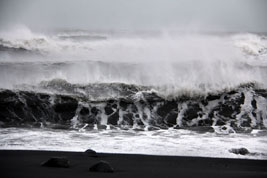
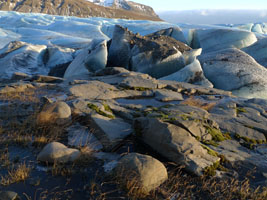
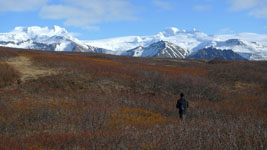
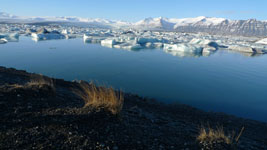
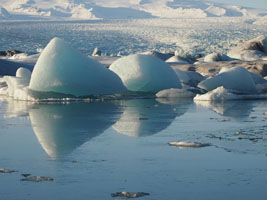
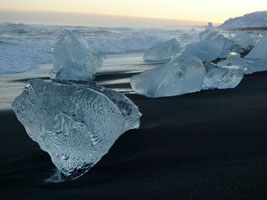
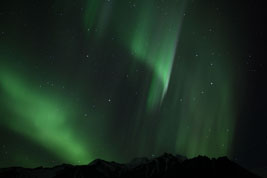
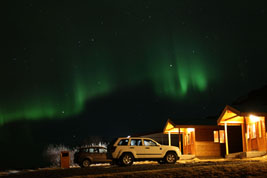
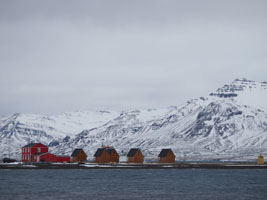
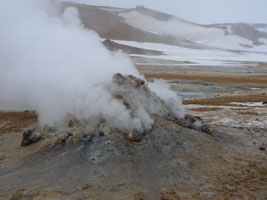
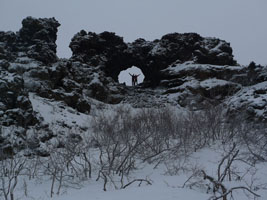
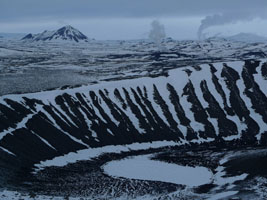
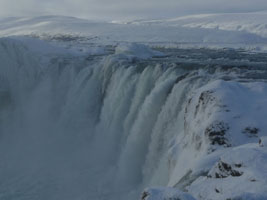
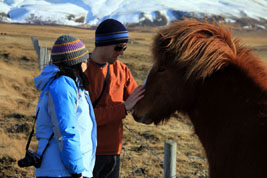
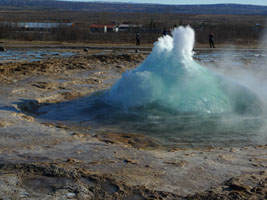
Three times in my life the sun has roused itself to a peak of activity, hurling flares and spawning sunspots that could swallow the earth. Volleys of stardust sweep through space towards our planet at more than a million miles an hour and race toward the magnetic poles, where high in the wispy upper vapors of the atmosphere they exhaust their energy and cause the air to glow green and red. I saw this once when I was young.
To see it again I went to Iceland in March with Joy and Sean and Jenn, timing the visit to coincide with the new moon, the supposed peak of the eleven year solar cycle, and a season with enough darkness to see the lights but enough daylight to see the country. As it turned out the sun was rather quiet and the weather was not often clear, but with the aid of several websites mapping real-time solar atmospheric activity and cloud cover we succeeded in both seeing the lights and capturing some of them on camera. Pictures don't tell the scene how it was, however; the dancing motions together with the silence, the cold, the sharp clarity of the lights, and the infinite number of stars in the sky made a surreal, magical scene that escapes description.
From San Francisco on a Thursday morning Joy and I flew north past a parade of volcanic peaks - the Three Sisters, Crater Lake, Mount Hood, the blasted remnant of Saint Helens, Mt Ranier, and others all stretched out in a line. Sean and Jenn joined us in Seattle. Darkness arrived soon on the flight to Reykjavik, but when we landed just before dawn it was only midnight on the US west coast making for a very long time with little sleep as we set out driving east into the frigid darkness. The treeless landscape was covered by snow in the hills and brown grass low by the ocean but in glass-enclosed greenhouses lush plants grew, fed all night by orange electric lights and kept warm by geothermal steam. The cafe where we ate breakfast had fresh flowers on the table, and the lettuce on my sandwich was freshly harvested. In this land where heat is plentiful and electricity is readily available from hydro and geothermal sources, these things are possible.
A strong gale was blowing on the south coast, a headwind almost doubling our apparent driving speed. The gas gauge plunged and gusts pushed the car sideways. I have never experienced such wind! Waterfalls sprayed straight up from cliff faces, trailing off into the air like clouds. When the wind slowed a white plume of falling water would start to push its way down the cliff, cautiously advancing and weaving back and forth like a snake, making little progress before being blasted back up again. Fortunately the beautiful Seljalandfoss, a large waterfall leaping from an overhanging cliff, was sheltered from the wind and plunged picture-perfect into its round blue pool. A walking path goes back under the cliff behind the falling water, and I followed it and became thoroughly wet from the windblown spray.
The powerful Skogafoss also was sheltered from the wind and rained down a flat sheet of water onto black basalt sand, hurtling off a strangely square cliff edge not worn away and looking more like a flash flood than an eons-old rivercourse. Iceland is, however, relatively young at just a few million years old (at its oldest parts) compared to Earth's oldest surface rocks which date back a few billion years.
Small farms dotted the landscape, their barns flanked by plastic-wrapped round hay bales stacked in such great quantity that the animals in the barn could not possibly finish it all before summer. Perhaps Icelanders store more than one winter's hay to guard against cold summers. Most of the sheep are still penned inside their barns in March; they roam the mountain pastures all summer and are rounded up in autumn. Evidently last year the snow came early and suddenly, and many sheep still out to pasture died from the cold.
The horses were outside, kept warm by their extra-thick fur coats. Icelandic horses have been an isolated breed for a thousand years, and they have become specialized for the climate: small, stocky, strong, furry, and amicable. Whenever we stopped nearby, curious horses would amble over to look at us and get a neck rub. We drove into one pasture and were promptly surrounded by the herd. Like a band of gypsies, the horses nibbled at our clothes and nosed into wheel wells and door handles. One rubbed its chin on the drivers' side mirror and pushed it out of alignment, and another gnawed on the hood to see if it was good to eat!
Iceland is best explored by imagining one's self as a Viking settler arriving in the late 800s to a land untouched by humankind. To that end, let me offer you some history: it was more than a thousand years after classical Greece, centuries after the fall of Rome, at a time when the Silk Road trade had long been been established. Among successful merchants, soldiers, and the political elite the extents of the known world were relatively accessible and probably felt a little crowded. Global navigation in the Age of Discovery was still five hundred years in the future but regional travel and the technology of transportation was well developed. The Norse (Vikings) were at the forefront of this advancement, having become proficient at building seagoing ships, and many people among them were keen to find new lands either for settling or for raiding. Arriving in uninhabited Iceland, which was thickly forested and teeming with fish and game, they knew the value of what they had found.
Within half a century the entire island was claimed and settled. A system of government and laws was established, and a network of riding paths linked various parts of the country. The climate was good, and there was ample land for grazing. Imagine the thrill of having made your way to such a place with abundant resources, isolation from competing kingdoms, and the free-spirited opportunity of a frontier culture. On top of all that, there were geysers and hot springs, volcanoes, waterfalls, and pretty landscapes beyond comparison. I get excited just thinking about the potential it holds - and that is today, with the trees all gone and the soil blown away.
These days a town along the southern coast might be only a handful of buildings, usually including a church and many barns. Farmers have few neighbors. Our accommodation for the night was at a guesthouse on a sheep farm near Vik, a working farm that probably makes more money from tourism than from sheep. They were just finishing a whole new wing of guest rooms. Before stopping for the night we drove about ten minutes farther along the road to downtown Vik, where we got bowls of hot soup at a cafe and ventured briefly onto the windy beach to have a look at the picturesque sea stacks offshore.
Back at the guesthouse, I met the resident Icelandic sheepdog which has a talent for catching snowballs. As darkness fell we gathered in the kitchen and prepared a tasty meal of chicken and rice, and then it was off to bed early for eleven hours of deep sleep.
Overnight most of the slushy snow on the ground melted away as warm rain fell but by 10am it was howling wind with snow flurries. Driving down to the beach, going with the wind at 35 mph, I suddenly realized the car was completely silent. Rolling down the window, I put my hand out and felt only the faintest wafts of air flowing past. We sailed along until I parked the car, whereupon the full force of the gale became apparent. Following the advice of our rental agency, we kept a white-knuckled grip on the car doors while opening them; like giant scoops they caught the air and would have bent themselves into mangled junk if left to find their own stops.
Pebbles and sand whirred past my ears and spray tore off the breaking waves as they thundered onto the beach. Walking was a challenge, and in the strongest gusts the pressure difference upwind to downwind made it noticeably more difficult to breathe. The surf was impressive, crashing against pointed dagger-like rocks offshore which rose from the depths like the talons of a fallen sea monster. Black hexagonal basalt columns ascended from the sea against the grassy cliffs, a marching army frozen in stone. Landscapes like this spawned the Icelandic traditions of trolls and fairies that still live on today. By the time I clambered back into the car, my pockets were heavy with windblown sand.
Heading east out of town, we soon drove into featureless expanses of gravel where the outflow from ice fields melted by erupting volcanoes periodically sweeps away everything. They call the empty gravel spaces the "sandar" - a lonesome word fit for the desolate wastes where only a few tufts of grass survive. On our map we saw emergency shelters marked at intervals along the seashore and it took me a moment to realize they are for fishermen. The tangible possibility of being wrecked out there made me dread the cold ocean; that Icelanders maintain these shelters and keep them stocked with dry firewood (we drove a gravel road that ended up at one, a natural cavern in the cliffs) was convincing proof of the hazards of fishing these waters.
There was some rice leftover from dinner which I had packed in a tupperware, and we ate that for lunch while out exploring the gravel flats. Farther along, we crossed into a bizarre landscape of pillowy green moss carpeting sharp black shards of lava. It looked as if the moss was engulfing everything, and that all of Iceland was at risk of disappearing under a creeping green sponge, but the moss is simply the first plant to take hold. It builds soil, and then other plants gain the advantage as the sharp lava is slowly tamed and turned into thickets of grass and shrubs.
Passing golden grassy farms and ice-fringed waterfalls, we drove onward through warm sunlight interrupted from time to time by snow and wind. Arriving in the big town - relatively speaking - of Kirkjubaejarklaustur after the little grocery market closed at 2pm, for provisions we had to make do with what was for sale at the gas station. In Iceland this usually includes hot food (burgers, hot dogs, grilled cheese sandwiches), canned pasta sauce, rice, potatoes, milk, cheese, bread, snacks, beer, and other basics. We would be staying two nights in a little cabin near Skaftafell national park, a place where glaciers almost reach the sea, and though we still had some groceries from the day before we bought more snacks and breakfast foods.
The sun was sinking low when we arrived at the park visitor center at 5pm, closing time. There was just enough time to book a guided walk on the glacier for the next morning, and have a quick look around at the exhibits. One of the glaciers is accessible by a gravel road that took us nearly to the ice; we parked there and walked to a meltwater pool backed by stunning blue ridges of ice rising into the mountains.
In winter when there is more rain than sun, the eroded white surface of the glacier is washed away leaving transparent blue ice in the most beautiful hues. All the air is pressed out of hard packed snow as it becomes layered deeper and deeper into the glacier and flows down from the ice field high above, and it is clear enough to see at least a meter into the ice. Huge blocks of ice, their sides shining and rippled as if scooped out with a spoon, were tumbled against the rocks. It made a pretty scene in the low sunlight, reflected in puddles of water among moss covered rocks and feathery tufts of grass.
Our cabin, home for the next two nights, was a fifteen minute drive to the east along the main road, in a tiny village set up against the mountains. Three little prefabricated wood cottages sat side by side looking out towards the coast. Ours was the middle one. It had two bunk beds, a bathroom with a shower and plenty of hot water, an electric stovetop, refrigerator, and kitchen sink, coffee maker, microwave, pots and pans and dishes, and a decent number of lights and electrical receptacles. Everything had a Scandinavian feel, in a large part because every implement and fixture came from IKEA - perhaps they even sell complete cottages. An electric heater kept it toasty warm, and there was wireless internet. On account of the close quarters this ended up being a great deal at half the cost of most of our other accommodations, and it was fun, at least for a short visit, to stay in such a cozy little cabin.
We made dinner and watched the websites for predictions of cloud cover and aurora activity. A great wall of dark clouds was holding fast just to the east, apparently deflected by the high mountains like a snowbank pushed aside by a plow, but to the west and north the sky was clear. Around 10pm we decided to drive back towards the glaciers, where the road turns south, and go along the road several miles out onto the gravel plains so the mountains would obscure less of the low northern sky. It was dark there all around with only a few distant lights on the horizon, and thankfully there was no wind. It was cold, minus five degrees Celsius.
On the northern horizon, there was a green glow! It was faint and might easily have been explained away as a trick of the mind if not for the colors brought out by our cameras with longer exposures. These revealed reds and swaths of green light arcing across the sky. Sean and I set up tripods and clicked away. While I continue to almost exclusively use point-n-shoot cameras for my photography, being of the opinion that for my usual distant landscapes in daylight the art is not about photographic equipment but rather about composing the frame, for the aurora I borrowed a good SLR. Thanks, Adrian! In low light, a large, high-quality sensor and a fast lens are essential.
The night's show of aurora borealis did not amount to much and we quit after an hour and a half, mindful that the following morning we had a glacier walk scheduled and many things to see.
At dawn I cooked us a hastily prepared breakfast of fried potatoes and then we set out for the park. It was just the four of us on the 10am glacier walk and no one else was around so it was very peaceful. Evidently in summer guide companies lead dozens of tourists around on the glacier! After outfitting each of us with crampons and also an ice axe that was more for show than actual utility, our guide Jon ("yohn") drove us up to the glacier and we walked a quarter mile or so to the edge of the ice. The light was beautiful - diffuse sunlight coming through clouds with some blue sky on the horizon, bringing out the soft blue of the ice.
First we went into what remained of an ice cavern which was melting and collapsing as the glacier inched forward. A small mound of dirt was pushed up from the last couple days' advancement at the edge of the ice and it was easy to see how the cavern could break up at any moment, so we stayed inside for less than a minute - just enough time to admire the beautiful blue color of the ice. The rest of our two hour walk was out on the tame, safe lower reaches of the glacier where the slopes were gentle and there were few crevasses. Jon led the way and told us about the ice, history, and geography.
Too soon it was time to turn back. Every distant ridge of ice promised to be more spectacular than the last, and I could have kept exploring all day! Instead we said farewell to Jon and set out hiking through what qualifies as an Icelandic forest, a hillside thick with birches about ten feet tall. White ptarmigan scampered through the underbrush. Back in the hills was Svartifoss, a formidable looking waterfall among hexagonal black basalt columns adorned with icicle daggers, a favorite of photographers. We saw so many serious photographers on our travels around Iceland - people equipped with massive tripods, all-weather clothing, and extensive collections of cameras and lenses aimed at the waterfalls and landscapes that I too was shooting. I felt completely out-gunned!
The ridge above Svartifoss was spectacular. Low red willow shrubs about a foot tall crept among the lichen-covered boulders. The colorful slope rose gently up to some snow-streaked craggy peaks to the north. The sky was blue and sunny, and to the east not far away rose an enormous mountain range freshly coated on every cliff face and snowfield with a dazzling pure white layer of snow. Not a speck of bare rock was visible. It was so massive and completely white, clean, and crisp - an adjoining perfect world, the realm of the gods. These were the tallest peaks in Iceland.
As we climbed higher the magic of the other-worldly heights just beyond the red willows faded as a yawning chasm opened up on the other side of the ridge. The pure white snowfields became dirt-strewn bare rock lower on the slopes, and a crush of shattered ice poured down the valley from the great ice field behind the summits. There was menace and danger and the path from our pretty meadow to the crystal snow now appeared fraught with peril.
The glacier was quite a sight to see, a river of broken ice advancing ever so slowly down to the enormous gravel flats that stretched to the ocean on the horizon. Evidently back in the early days of the settlement the glaciers were smaller, and the climate was more mild. The fluctuations of climate across many centuries still elude our efforts to explain them. Melting glaciers are surely helped along toward their demise by our hasty return of three hundred million year old carbon to the atmosphere, but I'm afraid that the pollution and extinction wrought by mankind is much more unfortunate and less acknowledged as a situation we must address.
Take for example the loss of Iceland's soil. After the last major glacial period, layers of soil were laid down for thousands of years by slow-growing plants that trapped volcanic ash and dust and windblown sand, building fertile soil that supported thick forests. When the plants were trampled, nibbled, and chopped to oblivion, the soil disappeared. Soil is sand and clay plus organic material mostly from plants; without replenishment with new plant material, the organics will eventually decay away to nothing but sand and clay which promptly erodes by wind and water. When sheep and horses and cattle destroyed the ecosystem of plants, most of Iceland became a barren wasteland and the wildlife that once flourished is now relatively rare.
This is a sad result of unrestrained human settlement, but at least it is reversible given enough time. Where there are protected lands within parks, small forests are again beginning to grow. Never mind whether there is or isn't more carbon dioxide in the atmosphere; I propose that we should be more concerned about the health of our soil and water and how clean the air is. Soils the world over - even in the heartland of America - are gravely threatened as chemical fertilizers have supported crops on what was once rich soil but now is poor sand or clay, and water pollution is widespread. Let the experience of Iceland be a lesson to us all that we must take care of our home.
It was mid-afternoon when we got back to the car, leaving just enough time to go see the icebergs at Jokulsarlon. We drove about an hour east from Skaftafell to get there and spent a while walking along the edge of the meltwater lagoon where ice calves off the glacier and drifts downstream and out to sea. The tide was coming in, and when we arrived the river ran vigorously upstream. This daily exchange of seawater keeps the lagoon from freezing, and the chunks of ice float around melting and rolling over from time to time, revealing fantastic hues of blue ice and delicately sculpted formations.
Two seals were in the lagoon, popping up here and there, and we saw ducks too. As the sun sank lower we moved across the road to the beach where chunks of ice swept out by the tides had been cast onto the black gravel. Ice in all shapes and sizes, colored blue or white or crystal-clear, was scattered on the sand and some larger pieces sat grounded in the pounding surf. It was stunningly beautiful, with the sun shining through the ice and the white sea foam washing in across the black beach. Arrayed down the beach, dozens of photographers clicked away. I got my feet wet trying to get the perfect shot at the water's edge.
The sun sank into clouds on the horizon but then re-emerged as we drove back west to the cabin and we got to see a second sunset. The last of the alpenglow lit the high snowy summits a wonderful shade of pink. With a new supply of groceries from a little market at the gas station near the park, we cooked up a good dinner washed down by Viking beer chilled outside in a snowbank. As soon as the dishes were clean, we jumped back in the car and set out for a dark place just up the road. The aurora was already showing, a green and red glow that soon became bright and active.
Curtains of light advanced across the sky, growing brighter and brighter, merging together, and then fading as other new shapes took form. The most intense displays showed individual rays or columns of light that traveled about as fast as a jet plane cruising overhead. As they drifted along, the rays pulsed and shimmered as if vibrating. At one point an intensely bright curtain looped into a circle like a giant lampshade. Later, rays erupted from behind the mountains like a green fountain. The show seemed to abate a couple hours later so we went back to the cabin, but just as we arrived there a new burst of activity lit up the sky and I scrambled to get the camera set up again for more photos. The lights were still dancing when I finally came in at midnight.
In the morning, broken clouds had returned and it remained cold. The road east took us into wintry places covered with snow. We stopped again at the lagoon for another look at the icebergs which were now making their way out to sea because the tide had reversed and water was flowing out of the lagoon. There were more extra-cute, extra-furry horses along the road near Hofn, where we bought more groceries and some sandwiches for lunch, and later we saw herds of wild reindeer introduced from Scandinavia. In some places the entire landscape was white - sky, land, and even the road surface. The mountains rose straight from the edge of the ocean and long fjords cut inland.
Ferries from Europe arrive in some of the eastern towns in summer, so these places were larger and more urban feeling even though most of the roads were narrow and wild. One short segment wasn't even paved! Our destination for the night, arranged the day before, was in Eskifjordur - a large town on a pretty fjord around the corner from a big aluminum smelter. In Iceland, seventy percent of all electricity generated is consumed by several big smelters. The ores are brought from overseas to the coastal facilities which are sited near big hydro dams and geothermal plants, often built just for the smelters, and processed into aluminum metal. The process is clean especially with the use of Iceland's abundant renewable energy sources, but the hulking factories still look bad. Maybe it's just a stigma we have toward heavy industry which is almost always a source of noise and pollution.
We stayed in a nice-looking wood cabin by the water, much larger than the one we had in Skaftafell, and I cooked up a big pot of chili for dinner. As the daylight faded to deep purple outside and a stiff wind whipped past on its way down the fjord to the ocean, we drank hot cocoa and relaxed in the warm cabin by the golden glow of burning candles. Since the sky was cloudy, we got a good night's rest for a change.
The road to the north was high and snowy but not very slippery. Our first destination was a perfect little waterfall among basalt columns near the big Hengifoss falls. Sean had figured out that if we walked through pasture land on the opposite side of the river from the main trail, we would arrive at the lovely overlook where a particular picture I found online had been taken. It was a ways up into the hills, farther than I expected, and needles of sleet jabbed at us all the way. The falls were just like the photo but partly obscured by snow and ice, with many of the hexagonal columns concealed from view and the green, orange, and blue colors of grass, gravel, and water turned to shades of black by the ice and gray light. It was still nice, worth the walk, just different from the way it looks in summer.
The landscape remained hidden away under snow as we drove onward toward Myvatn. The road to the big waterfall Dettifoss was closed due to snow, but in Namaskard the hot ground had melted the snow and the colorful hues of orange, white, red, and yellow showed brightly. Steam billowed out of the ground, gray pits of mud boiled, and the air smelled strongly of sulfur. The orange mud underfoot stuck to our boots layer upon layer, making us walk tall with heavy feet. Fortunately there were patches of crusty snow around on which we were able to rub the mud off our boots, so the car stayed relatively clean once we continued on our way.
I thought Lake Myvatn was not especially remarkable, perhaps even a small disappointment considering the attention it gets in guidebooks, but I must acknowledge that being blanketed with snow and mostly frozen the colorful landscape was hidden away. We have seen lava and sulfur vents and cinder cones in California, too, which reduced the novelty of it all. The turquoise blue pond at a geothermal plant was very pretty, its color the result of fuzzy pale blue microbes coating the rocks, and I also really liked the cinder cone Hverfjall.
We stayed in rooms at a guesthouse by the lake. There were cabins and motel-style rooms, and a communal kitchen. The property was also a residence and a farm. There was a border collie whose purpose in life was to fetch sticks, and outside the smokehouse there were freshly caught trout cleaned and hung by their tails over a pole, with blood frozen in crimson icicles on their snouts. A herd of curious sheep trotted up to me en masse when I approached. They looked up at me expectantly with big black eyes, milled around a little at my feet, and then abruptly turned their tails and sauntered off once it became clear that I was not distributing food. Unexpectedly, I felt sad at being rejected so thoroughly by sheep. Not even one hesitated!
For dinner we went to a cafe that shared a roof with a dairy. About two dozen cows and calves munched on hay in a very clean barn that had big glass windows down the center of the building looking into the cafe area. Most of the dining tables however were situated beside windows on the opposite side of the building where diners could admire the volcanic landscape while they ate. The milking room was positioned up against the bar. This was truly farm-to-table dining! The whole place smelled a little like cows, despite being separated from the barn by a wall.
The food was delicious. Our server brought fresh milk out for us to taste, still warm from the cow. We ate smoked trout and smoked lamb, fresh cheese, and a wonderful dark rye bread that they bake in pans set inside a geothermal steam vent. It's an Icelandic tradition and there are many recipes, dating back centuries. Rye from Denmark (Iceland is too far north to grow it) and sugar together with some yeast and salt are combined to make dough which is placed in a closed loaf pan and steamed for a long time, as much as 24 hours. They must have used sourdough cultures originally, and I wonder what sort of sugar was common. I suppose this tradition dates from a time when trade could easily bring sugar along with the rye.
In any case, the way it's made today a remarkable transformation takes place during the long bake: the light brown flour caramelizes to a deep brown like gingerbread and becomes sweet and cake-like, and very dense yet moist. It was fantastic and I immediately began planning how I might build a steam oven that can run unattended in my kitchen for 24 hours. The bread was not so diffent from various molasses cakes I've had before, but the challenge of making so dark and richly flavored a loaf from little more than rye and sugar is intriguing.
Our main courses were familiar European preparations of fish, meats, and stew. Unique Icelandic fare beyond the aforementioned bread mostly falls into an unappealing category born of hardship: dried slivers of white fish, jars of pickled fish, the rotting shark seldom seen outside tourist menus, and sheep heads which we saw neatly skinned, sawed in half lengthwise, and bagged in clear plastic for sale in the frozen food department, ready for stewing. In Iceland one also sometimes sees whale meat on the menu, which we did not eat, and horse meat, which I found tender and tasty. I remain hopeful that only the cantankerous horses are diverted to the steak supply, leaving the cutest and most amicable horses for companionship, thereby continually improving the breed.
Dinner finished with fabulous ice cream made in the kitchen a few yards away, halfway between us and the cows. The sun had by this time set and an ice fog had moved in, obscuring the sky, so we turned in for the night. However when we switched off the lights to go to sleep, Joy opened the blinds and discovered that the sky had cleared. I went outside and saw a faint green glow that became brighter and more active over the next thirty minutes. Some of the show we could watch out our windows, from the warmth of our room! The ice fog returned for a spell and then it cleared again revealing more dancing lights.
In the morning after breakfast we went walking in the lava formations. Sharp crunchy lava gravel, boulders, and towers covered an area where lava pooled, partially cooled, and then drained away. Under the ice fog with some light snow falling it was easy to get disoriented. There were lava arches and one cavern with a ceiling looking very much like a gothic arch, hence its name "the church". In some places the snow was deep enough to sink waist-deep, in part due to concealed holes among the sharp lava rocks.
We decided to try another road to the waterfall Dettifoss, but about ten kilometers in the way was blocked by a snowdrift impassable to our vehicle. I got us stuck for a few minutes to prove it. Next we tried to see the Krafla volcanic area but this was almost entirely covered with snow. The turquoise water pooled in a crater and the colorful rocks were all covered with plain white. We walked to the top of the crater anyway, about a mile up from where we parked near the sixty megawatt geothermal plant. They draw hot water from deep underground and use it to generate steam to run turbines.
As we were returning to Myvatn, the sun came out and I felt like I had to re-photograph everything because the lava and the lake looked so different in the golden sunlight. What before had been almost monochrome, visually appealing in a different way, had turned rich and full of light and shadows. We had lunch and then set out to climb Hverfjall, a striking cinder cone rising just a few miles away to the east. It was a stunning landscape of black and white, with distant volcanic peaks and steam vents on the horizon. Lake Myvatn was mostly iced over so we didn't ever get to see much of it, and the remarkable bottom-dwelling algae balls that live only at Myvatn and in one lake in Japan remained hidden away.
To wrap up our tour we drove along the south end of the lake and saw some small gravel craters from steam explosions, and more lava formations. Then it was off to the Nature Baths - the local version of Reykjavik's Blue Lagoon, both man-made hot springs fed from geothermal plant outflow, beautiful blue and steamy. We did not go to swim, however, just to admire the view from the cafe where we had dinner. There really weren't any other options for food mid-winter except for an upscale hotel restaurant. Swimming at the lagoon is best made a half-day activity, with ample time to visit the saunas and pools and perhaps partake of some spa treatments if you're into that sort of thing.
Clouds obscured the sky that night and I slept well, waking to sunshine and brisk cold that had deposited crystalline ice onto every twig. Snow sparkled as if scattered with diamonds. We left town going west and ascended over some hills where the temperature dropped to minus ten Celsius, the coldest we had seen yet. It was a day of driving, bypassing the northwestern peninsulas for lack of time. We passed through Akureyri, a town larger than any we had seen since Reykjavik, and then sped south through barren open country.
Our guidebook listed a pleasant hot spring thirty minutes walk from the end of a gravel road along our route so we set out to find it. The effort got off to a slow start when road descriptions did not match actual roads, and when I asked a man at the nearby gas station he had not heard of the hot springs. We drove up what seemed the most likely gravel road, twice, going farther the second time - six or seven kilometers along a two-rut rock track with some ice and snow - until we came upon a deep snowdrift. It became clear then from another map we had that the springs lay much farther still, so we turned back defeated. Had we been able to continue, it would have been another 5km drive plus almost 8km on foot!
Borgarnes, our stop for the night, is a medium sized town not far from Reykjavik. Our guesthouse was right along the water looking out to some sheltered bays and rocky islands, and there was a coastal path winding around the inlets that we followed for a few hundred yards to the local museum. Called The Settlement Center, it had two parts: first, an exhibit about the settlement of Iceland in the 800s and 900s, and next, an exhibit about one of the Icelandic sagas that took place locally. Both exhibits had excellent audio guides that we listened to as we walked around.
I learned how the settlers near Borgarnes organized and assigned people to harvest various local resources like the best trout stream, the best place to hunt ducks, the best place to graze sheep (which tasted better when fed on highlands shrubs rather than marsh grass), the best place to fish for salmon, and so on. It sounded like a very rich land, rather different from the treeless country it is now. The saga exhibit was very well done, a fine work of sculpture. We ate dinner at the adjoining restaurant, where Sean and I dined on tasty horse steaks from a local farm.
Friday morning we set out along the tourist route dubbed "the golden circle" past picturesque mountains, to the Atlantic rift fissures at Althing, then past the geysers at Geysir, and lastly the big waterfall Gulfoss before driving to Reykjavik late in the afternoon. There were many tour buses and customized jeeps on the road, and lots of tourists though I'm sure it was nothing like the summertime crowds.
We walked for a while at Althing between the cliffs of black lava where every so often tectonic plates burst apart and make Iceland slightly larger. The location is the site of the annual Icelandic parliament held for several hundred years starting in the year 930, and by the various accounts written at that time it does not seem to have changed much since. This was a good lesson on the scale of geological time.
At Geysir we watched a thirty foot tall cloud of hot water jet out of a hole in the ground every five minutes or so. I had never been close enough to a geyser to peer into the watery depths and see the steam boil up. About two dozen people stood around the pool, cameras aimed and ready for the next blow. In the enormous tourism and shopping center across the road, we bought some food and browsed outdoor gear, woolens, fox furs, reindeer pelts, and all sorts of knickknacks including metal cans of Icelandic air, the size and shape of soup cans, labeled "best enjoyed outside Iceland."
Gulfoss is a large waterfall - though evidently not as powerful as Dettifoss - and in winter the tectonic fissure into which it plunges becomes coated with ice from the spray. In the distance, beyond golden grassy plains, a chain of high snowy mountains glistened white against the blue sky. It was a beautiful scene.
Reykjavik is a bright, clean city with narrow streets and colorful rooftops. We stayed overnight at an apartment building operated like a hotel. It was nice to have the space, and the price was about the same as a hotel - maybe a little less - but we never had any use for the kitchen and did not spend much time sleeping in the bedrooms either, as it turned out, because of an early morning appearance of the Northern Lights.
At sunset the aurora predictions were looking very weak, worse than any we had seen yet, so despite the clear sky it seemed like our lights watching was over. We walked across town to a fish-n-chips restaurant that looked a bit like a coffee shop with a chalkboard menu, pastries in a glass case at the counter, beer on tap, and a short menu of various fish, yogurt-based dipping sauces, and potatoes fried several ways. It was not too formal and not too expensive, just what I wanted arriving travel-weary in this fashionable city.
Persistent to the end, Joy and I set alarms for 2am and 4am. When we woke, I was thrilled to discover that a significant solar disturbance had arrived. Measurements from the magnetic instruments we had been watching, taken at a research station on the other side of Iceland, were jumping up and down like a seismograph in an earthquake, and all the aurora maps were lit up at two thirds of maximum intensity! Outside, the sky was orange with scattered city light but I could still see the aurora.
The four of us set out sleepily in the jeep, heading west to a high snowy area about twenty minutes away where the orange city glow was low on the horizon and the sky was much darker. The lights appeared much more dramatic there. The entire sky was involved in a different sort of display, diffuse curtains of green swirled all around, motionless, fading in and out. Directly overhead, the lights formed interesting tent-like shapes. Sean and I set up our cameras and took photos until they all started to look the same. It was cold, in the low 20s, and working the buttons on the camera was a challenge with cold hands. Around 4:30am, after admiring the sky for an hour and a half, we returned to Reykjavik and got another four hours of sleep.
This began a prolonged period of warped time with little rest. We packed our things in the car, ate pastries, and walked to the iconic concrete church where we went up into the bell tower for a panoramic view. Afterwards, we had a good meal at an Italian restaurant. It was a beautiful sunny day, not too cold, perfect for exploring the city. At 3pm we returned the car at the airport and divided our last coins between the snack shop and a donations box. The plane took off as dusk was approaching but as we flew west the daylight went on and on until we got to Seattle. Flying west this far north seems to allow time travel, because the aircraft can almost keep pace with the rotating earth. Joy and I continued on to San Francisco, arriving late at night.
The rest of the photos are on another page.
See more aurora borealis photos here.
to the index page